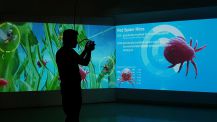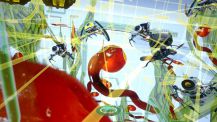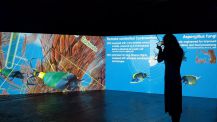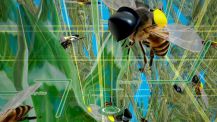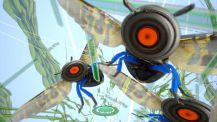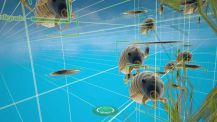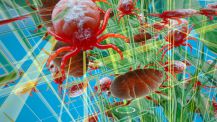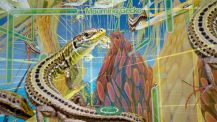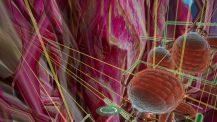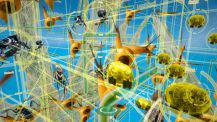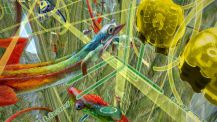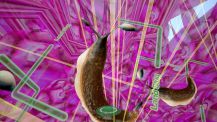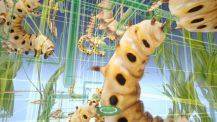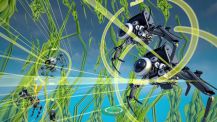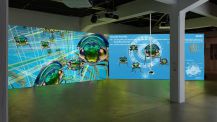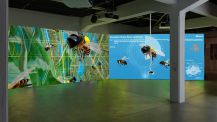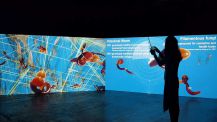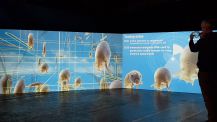Mobile App as Interface for Interactive Installations
Imagining a speculative future where technological solutionism has been taken to an extreme, CAON – control and optimize nature explores the potential of advanced technologies in the management of future ecosystems. In a habitat where animal, fungi, and plant species have been modified by technologies such as 3D printing, CRISPR and synthetic biology, you can observe how an AI optimizes and balances a delicate ecosystem. Interacting with a smartphone, through the perspective of an AI simulator, you are invited to fly with the created species, optimize them further, and observe the changing ecosystem. CAON responds to the trend of technology-assisted solution-making by constructing narratives of an uncomputable system under extreme control – what do we optimize, and what are we ignoring as a result? The project aims to inspect our tendency to simplify complex ecosystems by treating nature as a system that can be calculated and fixed.
Description
Due to global warming and species extinction, our planet is becoming increasingly uninhabitable. To mitigate this, scientists now increasingly rely on technology-assisted solutions such as genetic engineering, synthetic biology and artificial intelligence. Often assisted by our misguided instinct to control and optimize nature. CAON is a speculative project on the future of an ecosystem under extreme control that questions the limitations of techno-solutionist approaches to climate change and species loss. The narrative sets in a speculative simulation, 30 years from now, where artificial intelligence and synthetic biology work together to create an optimized environment for mutated species to withstand the increasingly hostile environment. A simulator powered by artificial intelligence creates hybrid animal, fungi and plant species to balance and control a delicate ecosystem in this imagined scenario. In Under a White Sky, author Elizabeth Kolbert pointed to “control” as the fundamental false logic of the Anthropocene: “If control is the problem, then, by the logic of the Anthropocene, still more control must be the solution.” As we navigate an increasingly delicate political atmosphere, techno-solutionism dominates conversations about climate change.
Artificial intelligence has become the star of the techno-solutionist way of thinking with its promises of creative problem-solving packaged in a “black-box technology”. The technology comes with its own human-imposed biases – what do we optimize, and who do we optimize for? When we try to compute an uncomputable system, whose needs do we consider and prioritize? CAON looks at some of the technologies we use today and imagines a future where artificial intelligence takes them to an extreme.
To eliminate yellow fever, for example, mosquitoes in Brazil are genetically engineered to make it impossible for their offspring to survive. However, research published by Evans et al. in 2019 shows that many offspring of the genetically modified mosquitoes have survived and are spreading and propagating further. Where is our growing ability to manipulate life taking us? We tend to rely on technology-based solutions such as genetic engineering, synthetic biology, and artificial intelligence, which usually have their own human-preferred benefits and are often supported by our misguided instinct to control and optimize nature. We already use machine learning technology for species identification and cartography – and it’s not hard to imagine a not-so-distant future where machine learning does the balancing act for us, and “optimize” for human objectives.
Each speculative species in the environment has a backstory based on scientific publications: Bees which lose the sense of orientation due to pesticides; Snails that are displaced by invasive species; Rice that is exposed to increasing drought and temperature. We imagine a future where technologies like 3D printing, CRISPR, and synthetic biology play a part in modifying species for a higher chance of survival – Bees with 3D-printed parts that restore their lost navigation abilities; Hawaiian land snails with snake DNA to control the introduced agate and wolf snail invasion; genetically modified drought, temperature and insect tolerant rice.
Speculative species
Each speculative species (2054) in the environment has a backstory rooted in real-life scenarios, based on scientific publications (2011 – 2022). They are not photoshopped, but rather generated by AI based on speculative descriptions using deep learning text-to-image generators Dall-E and Stable Diffusion. Examples:
Honey Bee |
2020 | Disease resistant genetically optimized microbiome, Laboratory research, Leonard et al., 2020 → |
| 2054 | Resilient strain of genetically engineered super bees with additional 3D-printed parts repairing their lost navigational abilities | |
Cockroach |
2022 | Remote-controlled equipped with a tiny wireless control module, powered by a rechargeable battery attached to a solar cell, Laboratory research, Kakei et al., 2022 → |
| 2054 | Optimized for long distance flights, equipped with advanced surveillance systems | |
Olive Fly |
2012 | Sterile insect technique development, Field trials, Ant et al., 2012 → |
| 2054 | Gene driven olive flies with glowing colors to attract predators as an environment-friendly insect pest control method | |
Flower Beetle |
2015 | Developed radio system to remotely stimulate free flying beetles by electrical stimulation, Laboratory research, Sato et al., 2015 → |
| 2054 | Remote controlled with lightweight solar cells and trained for uniform seed distribution |
Using the “Optimize” button, the audience can create further variation of all species. This extends the simulation with chaotic and unexpected sequences. Here is an example of honeybee “optimization” generated with Dall-E:
 |
 |
 |
 |
 |
Audience Experience and Impact
Through the point-of-view of an AI simulator, the audiences are invited to fly through a speculative ecosystem and optimize animal, fungi and plant species with a smartphone. Two projections synchronized via the Internet show the smartphone screen as well as statistics and background stories of the running simulation. If you approach one of the 74 species, it will display when, how and which research institutions mutated it, based on scientific publications. If you click the “Optimize” button, further variations of this species appear, as well as a speculative description of how it might be further “optimized” notionally in 30 years. At the same time, this extends the simulation and leads to chaotic and unexpected consequences. If you turn 360°, the biodiversity increases. The sonic sound experiences are specially composed for CAON and respond to all movements and navigation modes. Each speculative species has its own characteristic sound. Flying cyborgs, equipped with numerous cameras and sensors, monitor and control the environment. One learns how AI monitors, calculates, manages, and suggests optimizations in this speculative ecosystem. We hope to invite the audience to investigate our tendency to engineer nature and treat ecosystems as a system that can be calculated and fixed.
Screenshots
Research
CAON was partly developed during a residency at transmediale studio in Berlin and at a research residency in Pakistan in collaboration with Pro Helvetia, 2022.
Research included visits to institutions that practice genetic modification on animals, such as the Max Delbrück Center for Molecular Medicine in Berlin, LAMS, Department of Life Sciences in Lahore, and UVAS, Department of Wildlife & Ecology in Pattoki, Pakistan.
Credits
Marc Lee in collaboration with Shervin Saremi (Sound)
Shervin Saremi is an Iranian musician and audio-engineer, working in fields such as sonic computing, procedural sound design, and production. He has studied Electronic Production and Design at Berklee College of Music and is pursuing his research on immersive audio at Berlin University of the Arts (UdK).
Marc Lee is a Swiss artist. He focuses on real-time processed, computer programmed audiovisual installations, AR, VR, and mobile apps. He reflects critically creative, cultural, social, ecological, and political aspects. His work has been shown in major Museums and new media art exhibitions including ZKM Karlsruhe, New Museum New York, MMCA Seoul, Transmediale Berlin, Ars Electronica Linz.
